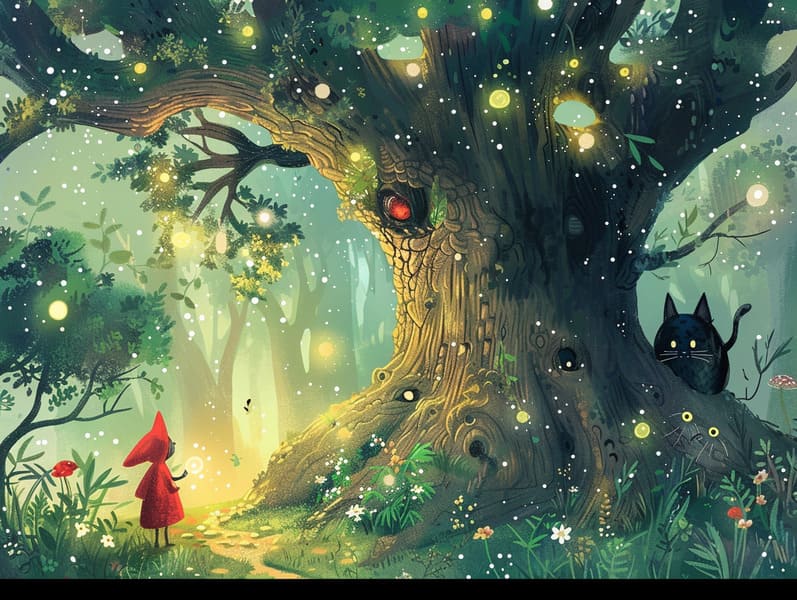
Short fairy tales have old origins. These narratives have been shared from one generation to the next ages before they were ever published. They originated from a variety of cultures, including Indigenous traditions. They were initially conveyed among elders, often carrying themes and messages related to the societal norms and beliefs of the time.
The renowned Brothers Grimm, Jacob and Wilhelm, were among the first to gather and publish many of these beloved tales. Their compilation, "Grimm's Story Collection," included stories like "Cinderella," "Hansel and Gretel," and "Snow-White and Rose-Red," which have since become classics in the world of iconic fairy tales. Similarly, Andersen's charming stories, such as "The Sea Maid," and "The Ugly Duckling," have floated into hearts worldwide, establishing their place in the pantheon of beloved fairy tales.
Even though they are old, these tales remain as impactful as ever, especially as children's night stories. These charming stories are now available in various formats, including colorful picture books, magical animations, and online fairy tales.
Their enduring popularity can be traced to several enchanting factors:
Important Morals: Traditional fairy tales often convey important moral lessons. Stories like "The Wolf and the Liar" teach the virtue of honesty, while "The Story of the Tortoise and the Hare" exemplify the qualities of steadfastness and humility. These narratives offer children clear distinctions between right and wrong, helping to shape their moral compass in a gentle yet meaningful way.
Empathy and Understanding: Timeless fairy tales frequently portray personalities facing trials and tribulations, inspiring audiences to connect with their struggles and back their triumphs. For instance, "Beauty and the Beast" teaches us the virtue of looking beyond appearances to realize the true being of a character, enhancing awareness and understanding.
Cultural Insights: Many classic fairy tales are saturated in the cultural contexts from which they blossomed. Reading these stories can provide delightful insights into different ways of life, building a sense of cultural respect and appreciation.
Inventiveness and Imagination: The mythical elements in ancient fairy tales—wizardry and magic—stimulate children’s fantasies. These tales guide readers to otherworldly realms, inspiring fantasy ideas and a sense of enchantment that remains a lifetime.
Classic fairy tales are not only fantastical but also edifying. They act as entrancing tools in advancing various cognitive and emotional skills in young readers. When classic fairy tales are voiced, they boost linguistic abilities by offering new linguistic elements and sophisticated sentence structures. This practice also develops auditory perception and mental focus, as young readers concentrate deeply, ready to see what happens next.
Furthermore, conversing about the themes and this site characters of classic fairy tales can advance problem-solving abilities and analytical skills. Kids are shown to discover patterns, guess what will happen, and grasp cause and effect. These examinations also benefit young ones express their thoughts and feelings, nurturing their emotional intelligence.
In today’s electronic age, the proliferation of online storybooks has made these tales more available than ever. Web-based platforms and software provide ample collections of timeless fairy tales that can be accessed or listened on anytime, anywhere. Fairy tales narrated are particularly well-received, providing an engaging way for kids to enjoy these alluring stories. Read-aloud books and read-aloud videos transport characters and settings to life, often accompanied by spellbinding background sounds and tunes that intensify the story journey.
The everlasting appeal of old fairy tales lies in their ability to adjust to contemporary times while staying true to their core values. Contemporary modernizations of these stories often spotlight more varied characters and modern settings, making them understandable to today’s audience. However, the essential messages of fearlessness, humanity, and justness remain unchanged, continuing to impact young listeners of all ages.
Old fairy tales also offer a sense of familiarity and predictability. They render a orderly narrative with a evident beginning, middle, and end, often finishing with the culmination of conflicts and the triumph of good over bad. This foreseeability can be solacing for young ones, making known a sense of stability in an fluctuating world.
Old fairy tales continue to delight and train new generations, maintaining their beauty and relevance in modern society. As children's bedtime stories, they provide a perfect blend of magic and knowledge, enriching moral values, empathy, and creativity. The presence of digital fairy tales and the prevalence of fairy tales recited assure that these classic stories remain attainable to new generations.
By defending and narrating these narratives, we continue to honor the rich tapestry of legends and cultural heritage. Whether you are perusing a beautifully illustrated book, enjoying a internet collection, or listening to an narrated book, the splendor of ancient fairy tales is always within reach. These fairy tales remind us of the perpetual spell of stories and its ability to unite us across time and space.
Be it you are delving into a richly illustrated book, experiencing a virtual collection, or listening on an sound book, the magic of children's fairy tales is always within reach.
These narratives reveal of the steadfast strength of narratives and its ability to unify us across time and space, making a tie that captivates and teaches alike.